“I Was the Family Misfit Who Got a Hopeful Ending to a Hard Childhood”

From the sanctuary of my rooftop, I listened as my family clamored around the dinner table, laughing, joking, and chatting away. In my usual hideaway, I gazed up at the stars and wondered why I never felt like I fit in anywhere, not even with my own family. At 15 years old, I felt like a misfit and a burden. I was certain my family would be a lot happier if I weren’t around.
Growing up around my siblings was tough. I longed for their approval, but “be quiet,” “sit still,” and “go away” were among their most common responses to me. My behaviors irked them and made me a target. It took a long time for me to understand what was so wrong about me and why I couldn’t connect the way I wanted to with my family. My behaviors, I learned, were primarily the result of undiagnosed ADHD and OCD, and my family was reacting to symptoms that were too difficult for them to understand at the time.
The Odd One Out
I remember driving my siblings mad at bedtime, to the point where they would yell at me to, “Shut up and go to sleep!” To be fair, I would talk non-stop into the night. As soon as my head hit the pillow, my brain lit up, filling with zig-zagging pathways of wonder and questions.
I wanted to talk about anything and everything. I had big existential questions. I wanted to discuss the deep connections I felt to some movie characters. I wanted to share a million facts about galaxies and talk in-depth about whatever book I was consumed by that week. But my sisters did not want any of it. Their neurotypical brains slowed down at night (as is normal), and sleep came easy. (Once I finally stopped talking, that is!)
It wasn’t just at night that I irritated them. My repetitive behaviors, like playing the same song over and over again (like over a hundred times each day) for months, or watching the same movie endlessly, also drove them away.
[Read: Parenting the Child Whose Sibling Has ADHD]
Sometimes, I’d fall into patterns of washing my hands so much they were red and raw. I’d also avoid touching anything with my hands or allowing anyone to touch me (I carried around hand sanitizer long before COVID). I couldn’t eat food that others had touched, and I couldn’t stand anyone sitting on my bedspread lest they leave behind germs.
My siblings often made fun of me for my “germaphobia,” and would intentionally try to rile me up by sitting on my bed or touching me with unwashed hands. Angry, emotionally dysregulated, and hypersensitive (which I later learned was rejection sensitive dysphoria), my responses to their teasing were deemed over-the-top. I would be disciplined for my “bad” behavior, and I frequently carried a deep sense of shame and embarrassment for being so “mean,” “crazy,” and such a “problem.”
I was constantly seeking affection and attention from my siblings, who only saw me as needy and overbearing. When they teased me, the physical heartache I experienced was real. When they pushed me away, the rejection I felt was so deep I found it debilitating. So, I’d retreat to the rooftop, just me and the stars.
This is a Victory Story
My siblings and I did the best we could do at a time when there was very little education or acceptance around behaviors like mine. We’ve all learned a lot along the way.
[Read: When ADHD Drains and Strains Sibling Relationships]
The behaviors I exhibited in childhood that caused so much strife were traits of real mental health conditions and neurodivergence — body-focused repetitive behaviors, OCD compulsions, and stimming (self-stimulation). I also learned that these behaviors were my way of self-soothing to reduce stress and anxiety. Today, diagnosed and treated, these behaviors (and trying to cope with them) sometimes still drive me (and my husband this time) crazy.
I’ve spent a lot of time masking and dealing with self-hate and insecurity, but that’s changing. Now, for the most part, I can speak openly with my siblings about the challenges I faced growing up around them as I dealt with undiagnosed mental health challenges. I understand myself better, and can take in their perspectives, too. We find ourselves reflecting on our own children, how we see so much of ourselves in them, and how learning and healing together forges a new path for them. We try to remember, for the most part, that just because things used to be a certain way doesn’t mean that they still have to be.
It’s a choice to see only the bad parts of the past; it’s a much better choice to focus on the victories instead.
ADHD and Sibling Strife: Next Steps
 CELEBRATING 25 YEARS OF ADDITUDE
CELEBRATING 25 YEARS OF ADDITUDE
Since 1998, ADDitude has worked to provide ADHD education and guidance through webinars, newsletters, community engagement, and its groundbreaking magazine. To support ADDitude’s mission, please consider subscribing. Your readership and support help make our content and outreach possible. Thank you.
















Leave a comment